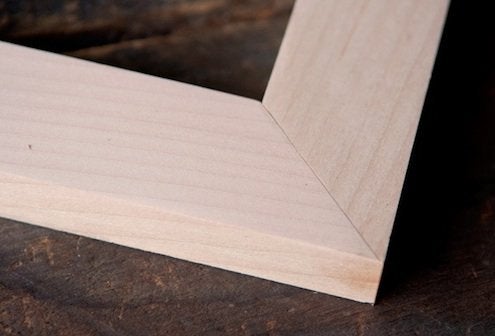Well, as promised I did the testing over the weekend. For those who don't want to wade through the particulars, the regular sawn miter performed significantly better than the ultra-smooth miter.
Test description:
Comparing a sawn miter glued joint with a mitered joint that had been made glass-smooth by using a guillotine blade on a Lion Miter Trimmer.
Sample preparation:
I had a 4 foot length of 3" nominal (2.5" actual) by 0.75" thick poplar which I chopped into four (4) 12-inch pieces. I then cut a 45 degree miter on one end of each piece using a Dewalt 12" compound miter saw with a 100 tooth blade. (Freud D12100X 100 Tooth Diablo Ultra Fine Circular Saw Blade for Wood and Wood Composites, 12-Inch ). This resulted in accurate and relatively smooth surfaces.
I then applied Woodworkers III (Titebond) to both surfaces of the sawn miters leaving a continuous "puddle" of glue. I allowed it to stand for one minute and applied more glue where the puddle disappeared. I then placed the pieces in a miter vise and applied sufficient pressure to obtain a tight fit.
For the second sample I used a Lion Miter Trimmer (guillotine cutter) to slice a very thin sliver of wood off the ends of the miters. This resulted in a glass-smooth surface.
Knock-off of Lion Miter Trimmer:
I glued up the trimmed miters in the same fashion as the un-trimmed miters. However in this case there was no need to add more glue to the "puddle" as none seemed to be absorbed.
The miters were glued up in this orientation:
There was generous squeeze-out for both samples. I wiped the excess off on the exposed side. I left the squeeze out alone of the reverse side.
I let the parts sit in the vises over night. Although Titebond claims that the glue is fully dried in 6 hours, they specify not to stress the joint until it had cured for 24 hours, so I waited until 2:00 p.m. to test the results.
The test:
I clamped the L-shaped pieces to a column in my basement about 2 feet off the ground with the pieces oriented like the letter "L".
I attached a chain to the free end of the 'L' about 1" from the end, effectively making the lever arm about 11". I used my barbell weights to stress the joint. My smallest weight is 5 pounds so I went up in 5 pound increments.
Results:
Both the joints surprised me with their strength.
The ultra-smooth guillotined miter failed at 65 pounds after about 30 seconds.
I allowed one minute of stress for each weight test. I watched the joint and fully expected to see some indications of failure just prior to the catastrophic failure. That was not the case. It let go without any warning.
The regular sawn miter let go at 100 pounds after about 30 seconds and also without any warning.
Examining the failed joints:
I examined the ultra-smooth miters and they remained ultra-smooth with just an appearance of a clear finish which was the glue residue. It was uninterrupted and perfectly even.
I examined the conventional sawn miter and it had a white-ish residue that looked like wood putty which I assumed was the mixing of the glue with any residual saw dust left in the pores of the wood.
I had tapped off the joints but did not use any compressed air to remove the residual sawdust. I followed that procedure because it is my standard one and I have never seen a magazine article recommending compressed air on the joints prior to joining.
Observations:
I was amazed on how strong the joints were, considering that miters are supposed to be among the weakest of all glued joints.
If they had been joined into a rectangle, there would have been no "lever arm" and the joints would have performed even better.
Many picture framers prided themselves on their ability to know exactly how much glue was required for a joint and still not have any squeeze-out. It is my opinion that in almost all those cases the joints were glue-starved to some extent. When plenty of glue was applied, the joints are stronger than expected.
Miter joints are uniquely subject to seasonal movement and after several seasons the joints will weaken. That is probably where the reputation for poor performance had grown.
I would also note that a single example of each joint is not sufficient for scientifically sound results. However, the differential was so large that I am confident that the standard sawn miter will prove stronger even with better testing.
I did try to do a test with a fine sanded miter, however, I found that I could not maintain the geometry sufficient for a tight miter when I tried using sanding blocks. So I abandoned that test.
As an aside, I did not expect the joints to go to that poundage and it turned out to be a more physical effort than I anticipated. I found myself hoping for a failure as I did not look forward to lifting more than 100 pounds with one arm while looping the chain with the other.
Someone else will have to do the future testing.










